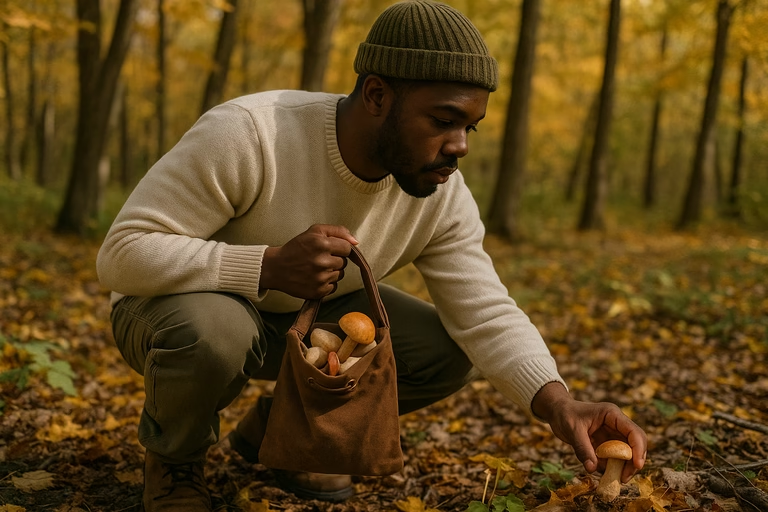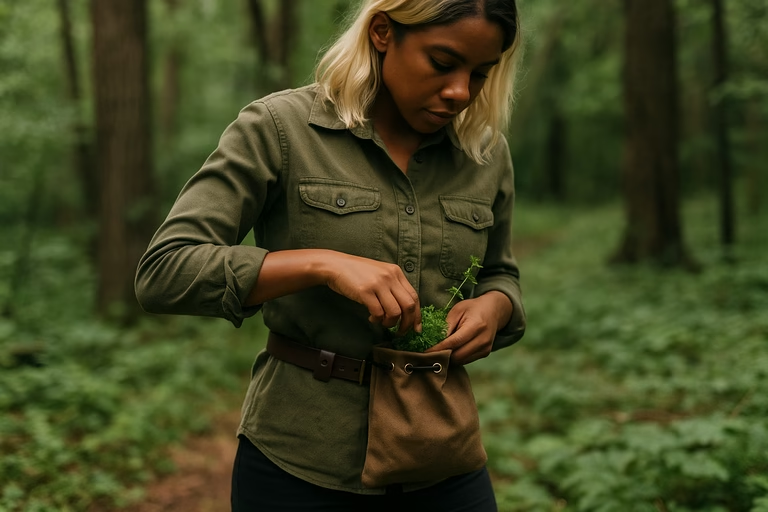In the wild, mobility and adaptability often make the difference between success and struggle. That’s why the foraging pouch has become an indispensable tool for bushcrafters, preppers, and nature-based foragers alike. Unlike bulky baskets or rigid containers, a foraging pouch offers flexibility, lightweight functionality, and hands-free convenience—making it perfect for fast-moving expeditions.
When venturing into dense underbrush, up rocky inclines, or across long trails, the last thing you want is to be burdened by heavy, awkward gear. A quality foraging pouch straps easily to your belt or waist, expands to accommodate your harvest, and folds away when not in use. In addition, it allows quick access so you can gather without breaking your rhythm. This combination of portability and practicality makes it a go-to item for anyone serious about foraging in dynamic environments.
Choosing the Right Foraging Pouch for Your Needs
Finding the best foraging pouch depends on your specific environment and harvesting goals. For instance, mushroom foragers often prefer pouches with mesh sides, which allow spores to scatter as you walk—helping propagate fungi across the forest floor. Meanwhile, berry pickers may opt for waterproof interiors to prevent staining or moisture build-up.
Foraging Basket: Your Key Tool for Foraging
In addition, consider the pouch’s closure system. A magnetic flap, drawstring, or buckle can prevent your harvest from spilling while still offering easy one-handed access. Material is another key factor: waxed canvas is durable and water-resistant, while leather offers classic style and long-term wear. For ultralight hikers, ripstop nylon might be the ideal balance between weight and resilience. Therefore, by matching your gear to your environment, you enhance both comfort and efficiency in the field.
The best foraging pouch is one that complements your movements, protects your harvest, and fits seamlessly into your kit. It shouldn’t slow you down—it should keep you moving smart.

How to Pack and Organize Efficiently
Once you’ve chosen the right foraging pouch, knowing how to pack it effectively is crucial. Start by lining the bottom with paper or cloth if you plan to harvest delicate items like berries or herbs. This helps cushion the first layer and prevents crushing as you collect more. For harder items like acorns or pine nuts, create small compartments using lightweight dividers or small cloth bags.
In addition, always carry a few essentials inside or attached to your pouch. A folding knife, field guide pages, and a small brush for cleaning dirt off mushrooms can all be tucked into external pockets. Some pouches come with built-in compartments or MOLLE systems for this very reason. Proper organization not only protects your finds but also saves time when identifying or separating species in the field.
Efficiency in the wild isn’t about speed—it’s about flow. A well-organized foraging pouch turns every trip into a streamlined, satisfying experience where every move has purpose.
Using a Foraging Pouch Through the Seasons
Seasonal changes impact not only what you gather, but how you gather it. In spring, your foraging pouch might be filled with tender greens, young shoots, and edible flowers like violet and dandelion. Summer brings juicy berries and soft herbs, requiring careful handling and breathable storage. Autumn introduces a variety of nuts, roots, and mushrooms that can be heavier and denser.
Therefore, it’s wise to adjust the contents and layout of your pouch as the year progresses. For example, add a waxed liner during rainy seasons, or extra mesh bags in fall when mushrooms are plentiful. In addition, clean your pouch thoroughly between trips to prevent mold, decay, or accidental cross-contamination of plant material.
Wild Food as a Gateway to Self-Reliance and Natural Living
Adapting your gear to the rhythms of nature reflects not only preparedness but also deepening skill. The more in tune you are with seasonal changes, the more valuable your foraging pouch becomes.
Foraging Pouch vs. Basket: When to Use Each
A common question among beginners is whether a foraging pouch can replace the traditional basket. The truth is, both have their place—depending on your style, terrain, and target species. Baskets offer more capacity and structure, which is ideal when gathering large quantities or transporting fragile specimens like wildflowers or certain mushrooms.
However, baskets can be awkward in tight spaces or on longer hikes. Pouches, by contrast, are better suited for exploratory trips, minimalist setups, and fast harvesting of smaller quantities. In addition, pouches can be folded and stored easily when not in use, giving them a clear advantage in terms of portability.
Therefore, consider your outing’s purpose and duration when deciding which to carry. Some seasoned foragers even bring both, using the pouch for initial gathering and the basket for long-term transport. Flexibility is key, and knowing how to use your tools to their strengths is a hallmark of experienced wilderness living.

Safety Tips When Foraging with a Waist Pouch
As convenient as a waist pouch is, it’s essential to use it safely and responsibly. When gathering in areas with dense vegetation or uneven terrain, your pouch can become snagged or weighted down. Therefore, adjust the straps to keep it secure but not restrictive. A loose pouch could shift your balance or interfere with movement, especially on inclines or near water.
In addition, always clean your pouch between uses. Cross-contamination between plant species or fungal spores is more than just inconvenient—it can be dangerous. If you’re collecting unknown species, consider placing them in separate containers inside your bag. And never store sharp tools like your foraging knife loosely; use sheaths or designated compartments. By treating your foraging pouch as a serious survival tool, you reduce risk and improve efficiency with every trip.
Teaching Beginners How to Use Foraging Gear
Introducing new foragers to the wild is deeply rewarding, but it requires structure and guidance. Start by showing them how to identify common plants and then transition into how to collect and store them properly. Demonstrating the use of gear like the foraging pouch gives beginners a practical entry point that doesn’t feel overwhelming.
Best Bug Out Bag: The Ultimate Guide for Emergency Preparedness
Encourage them to pack only what they can carry comfortably and to respect nature by taking small amounts. In addition, share the importance of cleaning tools, rotating collection areas, and observing local laws. A well-prepared forager becomes more confident and safe over time—and it all begins with mastering the basics, including how to use their pouch with intention.
Making Your Own Foraging Pouch from Natural Materials
For those embracing primitive skills or simply looking to reduce reliance on commercial gear, crafting your own foraging pouch can be a valuable project. Using materials like leather, canvas, or even strong bark fiber, you can design a custom pouch tailored to your needs. Start by cutting panels to size and reinforcing stress points with stitching or rivets.
In addition, add features like loops for tools or inner pockets for sorting different items. Creating your own pouch enhances your connection to your gear and builds essential bushcraft skills. It also allows you to experiment with capacity, structure, and utility until you find a design that works best for your foraging style. A handmade foraging pouch becomes more than equipment—it becomes a signature piece of your survival kit.

Integrating the Foraging Pouch into a Full Survival System
The more you explore wild spaces, the more you’ll appreciate gear that serves multiple functions. A foraging pouch doesn’t have to carry only plant material—it can also hold fire-starting kits, navigation tools, or small first-aid supplies. During emergencies, having essential items at your waist gives you fast access when seconds count.
You can also use the pouch to store edible insects, water purification tabs, or compact food rations. In wet weather, it’s ideal for stashing a dry pair of socks or keeping your map sealed in a waterproof bag. In addition, attaching your pouch to a larger pack or modular belt system turns it into a flexible extension of your entire loadout. The more versatile your tools, the more adaptable you become in unpredictable conditions.
Quick Recap
Let’s wrap up everything we’ve covered in this complete guide to using a foraging pouch as part of your survival gear.
We began by defining the role of the foraging pouch—its portability, ease of access, and how it complements fast-paced, mobile foraging. You learned how to choose the right pouch based on material, closure style, and seasonal needs. Then we explored efficient ways to organize your harvest, protect delicate plants, and keep essential tools within reach.
We also examined seasonal adaptability, showing how a smartly packed pouch can support you year-round. You saw how to compare pouches to baskets and when each is most effective. From there, we covered safety tips, beginner education, DIY pouch creation, and how to use your pouch as part of a complete survival system.
Ultimately, the foraging pouch is far more than a storage bag. It’s a strategic tool that supports efficient harvesting, increases your mobility, and keeps you prepared in the field. Whether you’re out for a short hike or living off-grid, mastering this one piece of gear elevates your entire wild food experience.

